|
|
 Fran Ridge |
|
|
 Fran Ridge |
LAVA TUBES, SKYLIGHTS &
ANOMALIES/
Mare Ingenii / LUNAR FAR SIDE
 Future astronauts approach opening
to a collapsed lava tube
August 4, 2016, updated Feb 27, 2021 Fran Ridge: In a paper concerning the search for evidence of extraterrestrial intelligence on the moon, ASU's Paul Davies mentioned several avenues of research. One of those things we should check are collapsed lava tubes or "skylights". In our routine live and recorded scanning of the moon with the Lunascan Project we encountered many things other than the fantastic views of huge craters with central peaks that always steal the show. At just the right lighting angles, always interesting are the rilles and wrinkle ridges, some with rare impact craters interrupting their meandering courses. These rilles are really exposed subsurface lava tubes that meteorite impacts have occasionally opened up. These are extremely interesting features. Could an exposed lava tube explain or have anything to do with the potential anomalies discovered in Paracelsus C? Paul Davies:Which is why we contacted the European Space Agency in the summer of 2020 about using their new lander to check out Paracelsus C. ESA was requesting some mission plans and had over 300 of them to go over. But with all the potential PR value of a mysterious and interesting mission to the backside, even an unmanned one, neither NASA nor ESA has taken this on. However, I must say that ESA at least looked at our proposal, many of their scientists did so. Mark Carlotto, Ananda Sirisena, and I at least tried to get ESA involved. But it isn't over. I have found someone who is excited about this find, whether it is artificial or natural, just as exciting as the rest of us. But that part is in-progress and we'll be talking about that later. These lava tubes are
sub-surface tunnels that are believed to have
formed during basaltic lava flows. When the
surface of the moon cooled, it formed a
hardened cover that contained a lava flow
beneath the surface in a conduit-shaped
passage. Once the flow of lava subsided, the
passage may have become drained, forming a
hollow tunnel. Lunar lava tubes are formed on
surfaces that have a slope that ranges in
angle from 0.4–6.5°. Lunar lava
tubes may be as wide as 500 meters
(1,600 ft) before they become unstable
against gravitational collapse and seismic
events or meteoroid bombardment can expose
them.
The existence of a lava tube is sometimes
revealed by the presence of a "skylight", a
place in which the roof of the tube has
collapsed, leaving a circular hole. One
particular LRO imaged recently grabbed my
attention and triggered renewed interest in
something that has intrigued me with our
live imaging. We'll probably never look at
rilles and wrinkle ridges the same way we
use to. And we'll very probably be looking
at rilles more often and for longer periods. 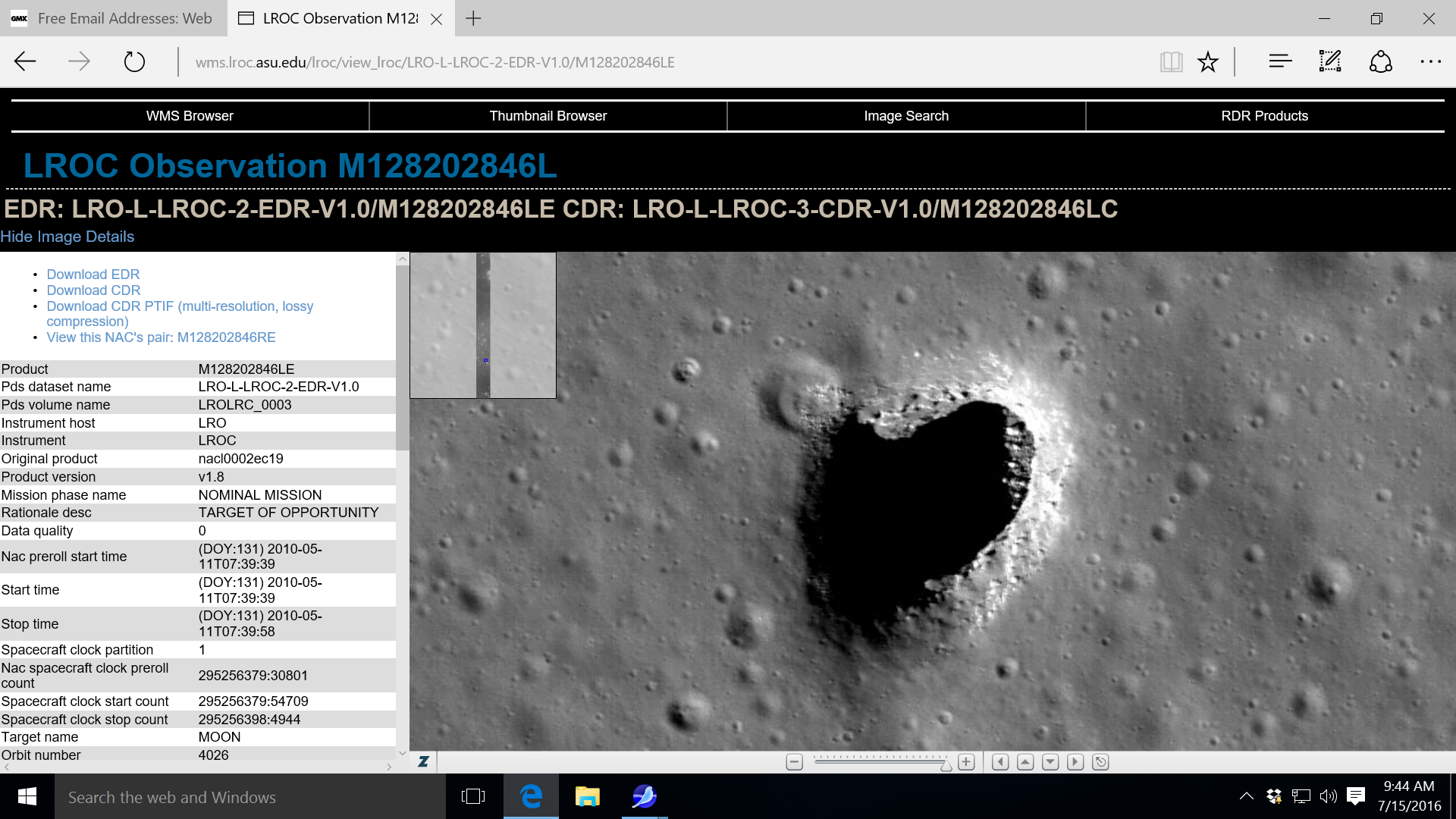 M128202846LC The Lunar Reconnaissance Orbiter
Camera has taken a closer look at what is thought
to be a skylight into a lava tube in the Mare
Ingenii (The Sea of Cleverness) region, one of the
few lunar mare features on the far side of the
Moon. This skylight (located at 35.95°S, 166.06°E)
is huge — about 130 meters (427 feet) in diameter
— and is probably the result of a partially
collapsed lava tube. But lunar geologists really
were not expecting to see this kind of unusual
feature in this region. Previously, a skylight, or
open pit was found in the Marius Hills region in
the Ocean of Storms on the near side which is
filled with volcanic domes and rilles where a lava
tube might form. However, those kinds of volcanic
features are not found in Mare Ingenii.
This could be an important find for several reasons. Lava tubes are important in understanding how lava was transported on the early moon, but they could also provide a home to future human explorers. This one on the far side would be a great place to set up a base for future telescopes proposed for observations out into the Universe from the Moon’s far side. The Moon’s surface is a harsh place, the human body doesn’t do well when exposed to the constant radiation present on the Moon’s atmosphere-less environment. Long term human presence would work if astronauts could spend most of their time shielded underground. While excavating a hole large enough to fit an entire moon colony in it would be a huge engineering challenge, these lava tubes could provide ready-made locations for a well-shielded base. 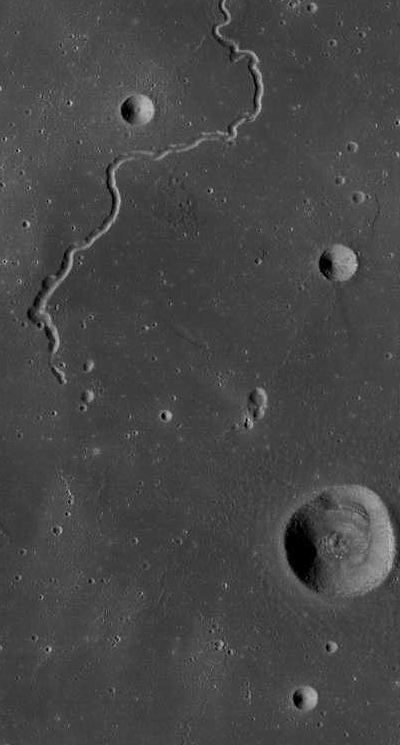 LROC Wide Angle Camera mosaic of
Rima Marius (100 m/pixel)
Our live and recorded imaging
gives us a 600 mile SIMRANGE but nothing close to
this LROC view which shows the termination point
of the rille northwest of Marius C.
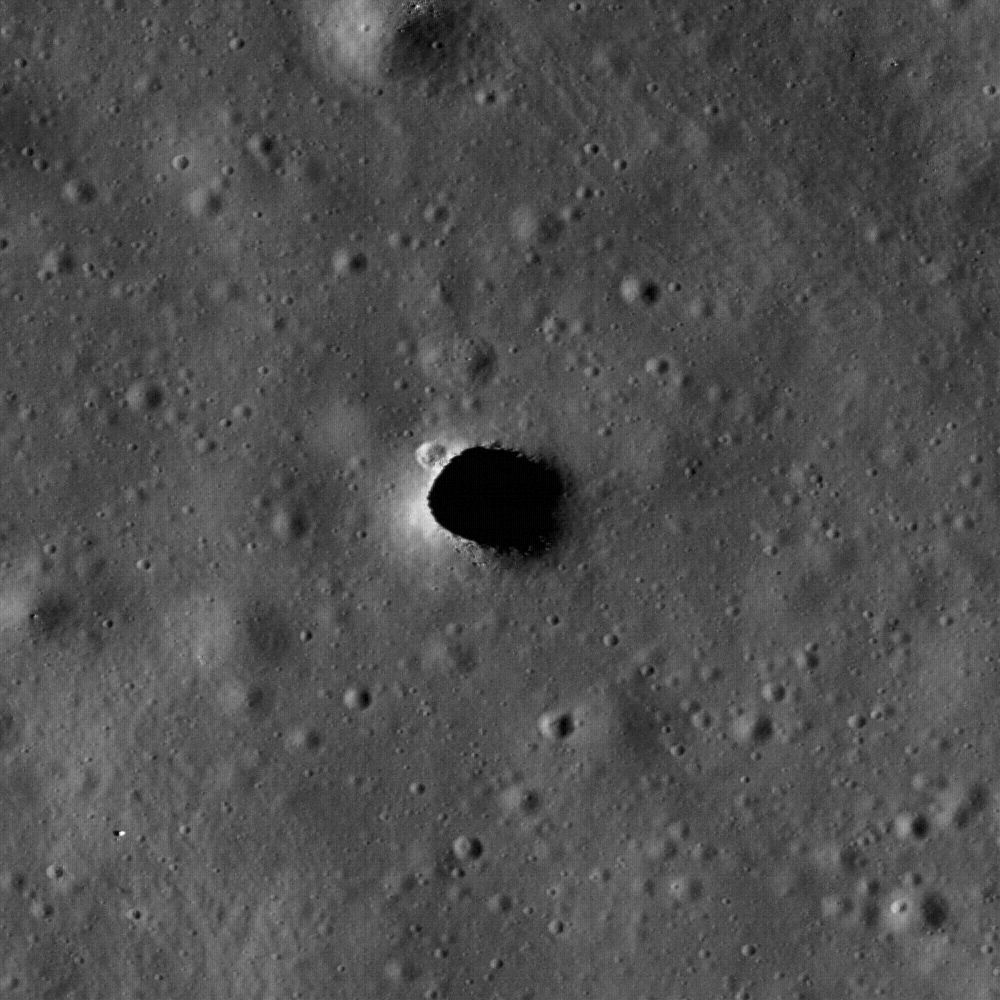 The Marius Hills "skylight" SELENE/Kaguya Terrain Camera team
made a fly-over movie at 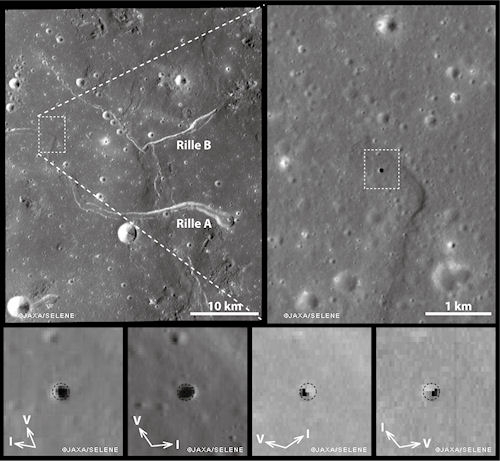 Marius Hills
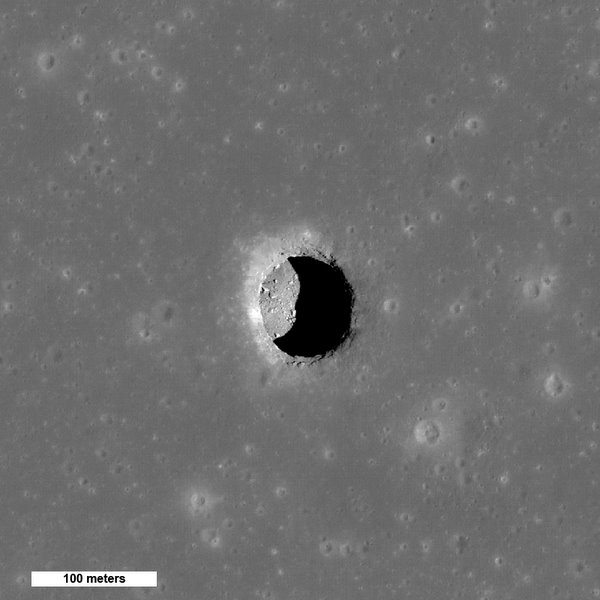 M126710873R Spectacular high Sun view of the
Mare Tranquillitatis pit crater revealing boulders
on an otherwise smooth floor. Image is 400 meters
wide, north is up, NAC M126710873R
[NASA/GSFC/Arizona State University]. A total of
nine LROC images for the skylight above were found
using their coordinates. (See below)
To request another location, enter lat,lon in decimal and press submit.
If you had any doubt about the possibility of "skylights" on the moon when you read Dr. Paul Davies paper mentioning three they had discovered on LROC images, then I'm sure you became more interested when it was found that there were over 200 such (or similar) features later documented. If that wasn't enough, then this image should be very compelling. The holes on the rilles are not random meteorite impacts. 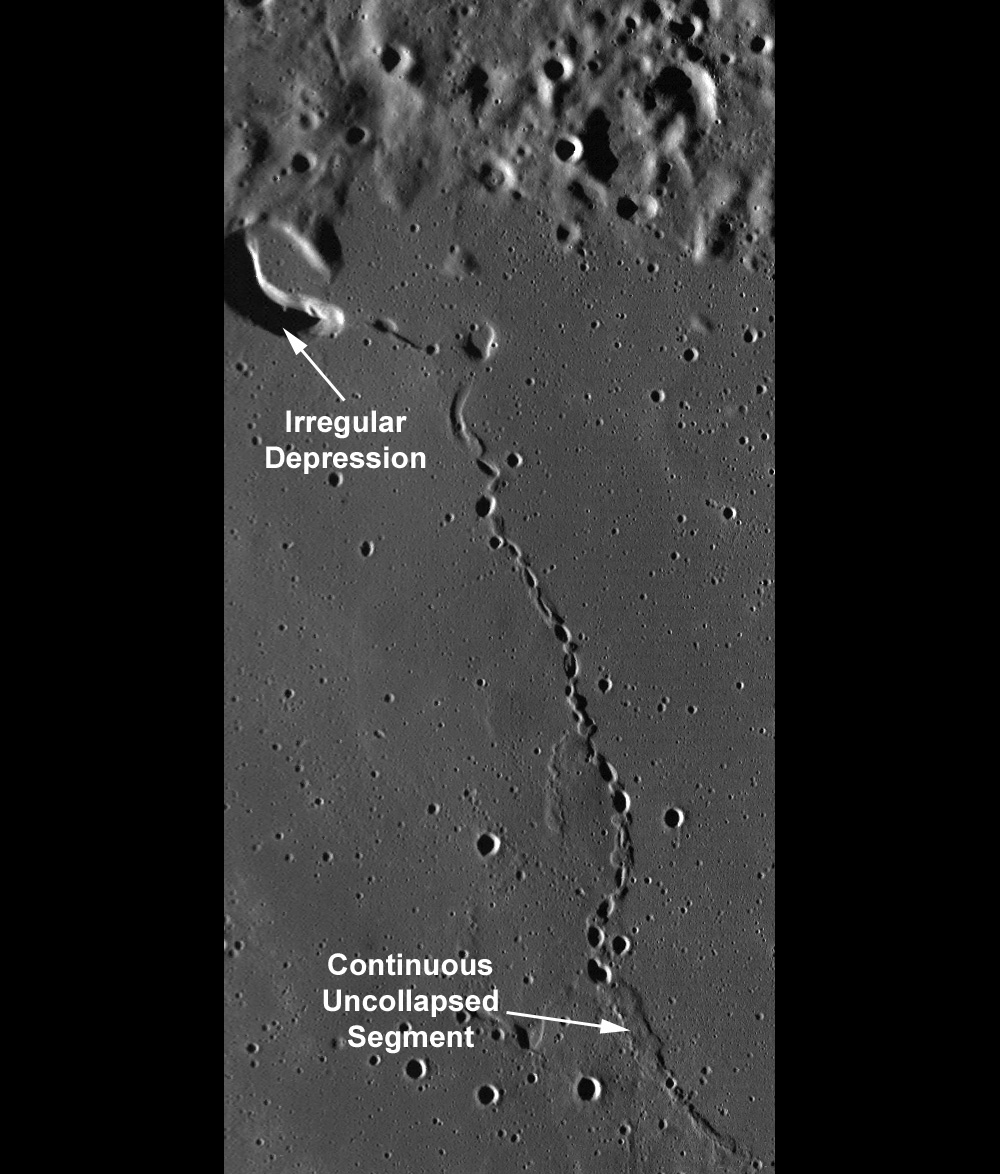 WAC frame M117773324
I hope to update this report with other images of suspected "skylights" and interesting comments and/or criticisms, related web sites, etc. The question raised, but not yet answered, is could a skylight termination or the end segment of a subsurface lava tube account for the anomalies at Paracelsus C? And are there any signs of a lava tube anywhere near that crater on the Far Side of the moon? My opinion is that surfaced lava tubes, if in existence, should not overlap, should be the same size where they break, and should run in the same direction. The formations in Paracelsus C don't follow those rules. Regarding the potential anomalies in
Paracelsus C, it has been discovered that the
structure referred to as "B" looks like a
"entrance way", and is consistent with what an
end-segment of an exposed lava tube might look
like, except that the formation of such usually
occurs where rilles are known to be in the
region. But large scale changes to the
landscape, possibly due to mining or quarrying
could be difficult to identify in LRO images due
to accumulation of lunar dust due to meteorite
impacts. If geometric outlines remain, it might
provide compelling evidence of extra-terrestial
activity. That's one of the reasons why both
targets of interest, "A" & "B" and some of
the local features cry out for further analysis.
Fran Ridge, Coordinator, The Lunascan Project Member, Society for Planetary & SETI Research skyking42@gmx.com ==================================== FOR MORE INFORMATION ON LAVA TUBES: Down The Lunar Rabbit Hole http://science.nasa.gov/science-news/science-at-nasa/2010/12jul_rabbithole/ There Could Be Lava Tubes On The Moon, Large Enough For Whole Cities http://www.universetoday.com/119634/there-could-be-lava-tubes-on-the-moon-large-enough-for-whole-cities/ A Search For Intact Lava Tubes On The Moon http://www.nss.org/settlement/moon/library/LB2-208-LavaTubes.pdf LRO Takes Closer Look At Moon Caves http://www.universetoday.com/73659/lro-takes-closer-look-at-moon-caves/ Skylights http://the-moon.wikispaces.com/Skylights LROC/ Lunar Pits http://lroc.sese.asu.edu/images/nasm/31 Lunar Pits Evidence of Collapsed Lava Tubes http://beforeitsnews.com/space/2011/03/are-lunar-pits-evidence-of-collapsed-lava-tubes-453454.html YOUTUBE VIDEOS: New Evidence Reveals Large Underground Caves In The Moon https://www.youtube.com/watch?v=UzoIL0CTS_8 |